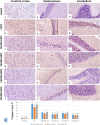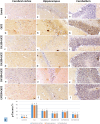Metabolomics analyses and comparative insight to neuroprotective potential of unripe fruits and leaves of Citrus aurantium ethanolic extracts against cadmium-induced rat brain dysfunction: involvement of oxidative stress and akt-mediated CREB/BDNF and GSK3β/NF-κB signaling pathways
- PMID: 39760898
- PMCID: PMC11703990
- DOI: 10.1007/s11011-024-01513-6
Metabolomics analyses and comparative insight to neuroprotective potential of unripe fruits and leaves of Citrus aurantium ethanolic extracts against cadmium-induced rat brain dysfunction: involvement of oxidative stress and akt-mediated CREB/BDNF and GSK3β/NF-κB signaling pathways
Abstract
Serious neurological disorders were associated with cadmium toxicity. Hence, this research aimed to investigate the potential neuroprotective impacts of the ethanolic extracts of Citrus aurantium unripe fruits and leaves (CAF and CAL, respectively) at doses 100 and 200 mg/kg against cadmium chloride-provoked brain dysfunction in rats for 30 consecutive days. HPLC for natural pigment content revealed that CAF implied higher contents of Chlorophyll B, while the CAL has a high yield of chlorophyll A and total carotenoid. Fifty-seven chromatographic peaks were identified by UPLC/MS/MS; 49 and 29 were recognized from CAF or CAL, respectively. Four compounds were isolated from CAF: 3',4',7 -trihydroxyflavone, isorhainetin, vitexin, and apigenin. In vitro studies outlined the antioxidant capacity of studied extracts where CAF showed better scavenging radical DPPH activity. Results clarified that both extracts with a superior function of CAF at the high adopted dose significantly ameliorated CdCl2-induced neuro-oxidative stress and neuro-inflammatory response via restoring antioxidant status and hindering nuclear factor kappa B (NF-κB) stimulation. Moreover, it up-regulated the levels of phospho-protein kinase B (p-Akt), phospho- cAMP-response element binding protein (p-CREB), and brain-derived neurotropic factor (BDNF) levels, and elicited a marked decrease in the content of glycogen synthase kinase 3 beta (GSK3β), besides amending Caspase-3 and hyperphosphorylation of tau protein in brain tissues. Moreover, a significant improvement in the rats' behavioral tasks of the CAL and CAF-treated groups has been recorded, as indicated by marked preservation in locomotion, exploratory, and memory functions of the experimental rats. In conclusion, the reported neuroprotective impacts of C. aurantium extracts may be through modulating p-AKT/p-CREB/BDNF and / or p-Akt/ GSK3β/NF-κB signaling pathways.
Keywords: Citrus aurantium; Cadmium; Cognitive function; Flavonoids; Neurotoxicity.
© 2025. The Author(s).
Conflict of interest statement
Declarations. Ethical approval: This work was carried out in compliance with the ethical procedures and policies delineated in the National Institutes of Health guide for the care and use of Laboratory animals (NIH Publications No. 8023, revised 1978)., the ARRIVE guidelines and international legislation, which approved by the Medical Research Ethics (MREC) Committee of the National Research Centre, Dokki, Giza, Egypt (Approval no. 7441201-2023). Consent to participate: Not applicable. Consent to Publish: Not applicable. Competing interests: The authors declare no competing interests.
Figures








Similar articles
-
The pantothenic acid derivative dexpanthenol ameliorated doxorubicin-induced neurotoxicity via regulating AKT/CREB/BDNF and AKT/NRF2 signaling pathways.Mol Biol Rep. 2025 Feb 13;52(1):228. doi: 10.1007/s11033-025-10228-5. Mol Biol Rep. 2025. PMID: 39945917
-
The potential role of Tirzepatide as adjuvant therapy in countering colistin-induced nephro and neurotoxicity in rats via modulation of PI3K/p-Akt/GSK3-β/NF-kB p65 hub, shielding against oxidative and endoplasmic reticulum stress, and activation of p-CREB/BDNF/TrkB cascade.Int Immunopharmacol. 2024 Jun 30;135:112308. doi: 10.1016/j.intimp.2024.112308. Epub 2024 May 23. Int Immunopharmacol. 2024. PMID: 38788447
-
Metabolomic Profiling and Neuroprotective Effects of Purslane Seeds Extract Against Acrylamide Toxicity in Rat's Brain.Neurochem Res. 2021 Apr;46(4):819-842. doi: 10.1007/s11064-020-03209-6. Epub 2021 Jan 13. Neurochem Res. 2021. PMID: 33439429
-
Signaling Pathways Involved in the Neuroprotective Effect of Osthole: Evidence and Mechanisms.Mol Neurobiol. 2024 Feb;61(2):1100-1118. doi: 10.1007/s12035-023-03580-9. Epub 2023 Sep 8. Mol Neurobiol. 2024. PMID: 37682453 Review.
-
Is lithium neuroprotective? An updated mechanistic illustrated review.Fundam Clin Pharmacol. 2023 Feb;37(1):4-30. doi: 10.1111/fcp.12826. Epub 2022 Aug 30. Fundam Clin Pharmacol. 2023. PMID: 35996185 Review.
References
-
- Abdel-Aleem GA, Khaleel EF (2018) Rutin hydrate ameliorates cadmium chloride-induced spatial memory loss and neural apoptosis in rats by enhancing levels of acetylcholine, inhibiting JNK and ERK1/2 activation and activating mTOR signalling. Arch Physiol Biochem 124:367–377 - PubMed
-
- Al Olayan EM, Aloufi AS, AlAmri OD, Ola H, Moneim AEA (2020) Protocatechuic acid mitigates cadmium-induced neurotoxicity in rats: role of oxidative stress, inflammation and apoptosis. Sci Total Environ 723:137969 - PubMed
MeSH terms
Substances
LinkOut - more resources
Full Text Sources
Research Materials

